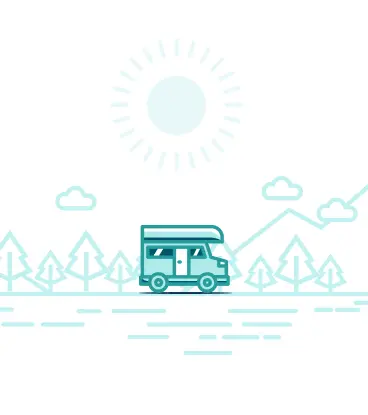
Know Before You Go, Olympic National Park

Start Planning!
You’re about to go on an epic adventure at Olympic National Park! Here’s what you need to know before you go.
- The tour has two starting points: Sequim, less than a mile west of Sequim Ave/City Center exit on Hwy 101 heading west/counterclockwise, and about 18 miles/20 minutes north of Hoquiam on Hwy 101 heading north/clockwise.
- The park is open 24 hours a day, year-round. However, some roads, campgrounds, and other visitor facilities have varying hours depending on the season. Learn more here.
- There are limited restaurants in and around the park. Plan ahead!
- Hurricane Ridge and Hoh Rain Forest Entrance Stations are extremely busy during peak season - arrive early.
- Hurricane Ridge Shuttle - Clallam Transit offers inexpensive shuttle service from downtown Port Angeles to the Hurricane Ridge Visitor Center Memorial Day weekend to Labor Day weekend.
- The tour is available in two directions - clockwise and counterclockwise.
Budgeting and Hours of Operation
 Shutterstock Image
Shutterstock Image
Budget
How much you spend truly depends on what you do along the tour route, but here’s a breakdown of some costs.
- Entrance to the park is $30 per vehicle.
- The Forks Timber Museum charges a minimal admission fee.
Hours of Operation
Although the park is open 24 hours a day, year-round, some roads, campgrounds, and other visitor facilities are closed or have reduced hours depending on the season. Learn more here.
Get Packing!
Here’s our packing list for this tour. It may seem a little long, but remember, what you bring depends on the activities you choose to do for the day.
- National Park Pass (or Forest Service Pass for trails on the south shore of Lake Quinault)
- Cell phone (with tour downloaded!)
- Car charger
- Phone mount for car
- Ziploc bag or waterproof cover for phone/camera
- Flashlight - for sunrise or sunset hikes to the beach
- Park Map - available at the visitor center
- Binoculars
- Waterproof rain jacket or coat
- Non-cotton/waterproof or quick-dry pants
- Dress in layers (layer with NON-cotton fabric like fleece/wool–for cooler weather or synthetic materials like nylon–for warmer weather). The key is to stay warm and dry!
- Waterproof hiking boots/sturdy shoes with non-slip soles
- Wool or non-cotton socks
- Trekking poles (recommended if hiking in the mountains)
- Sunscreen
- Sunglasses
- Hat
- Insect repellent
- Water bottles - plenty! Do not drink from any streams/rivers to avoid giardia.
- Snacks and/or picnic food (Remember to pack up leftovers/don’t leave crumbs) *Restaurants are few and far between. Make sure you plan ahead for meal times.
- First aid kit/medications
- Emergency roadside assistance kit
- Swimsuit and towel if interested in visiting Sol Duc Hot Springs Resort
TIP: Avoid wearing bright-colored clothing (light blue, pink, red, orange) or perfumed scents on day hikes in the forests. These attract wasps, especially during the fall
Best Time to Visit
 Shutterstock Image
Shutterstock Image
So, when is the best time to visit Olympic National Park? Each season has its perks.
Summer
July and August are the most popular times of year to visit.
The wildflowers are in bloom, and most trails and roads are open.
It’s also when temperatures are pleasant, ranging from mild to warm.
It can still rain during this time of year, so plan on bringing your lightweight raincoat just to be safe.
If you come at this time of year, you’ll wanna hit the trail early in the day or later in the evening to beat the crowds.
Summer is a good time to check out the less-visited sections of the park.
Fall
The fall months are a lovely time to visit.
With many families back in school, the park is less crowded.
And while the weather definitely gets cooler, it’s still pretty mild at the beginning of fall.
October is one of the best months to try to see the salmon jump at the Salmon Cascades or whales migrate down the coast.
Towards the end of fall, some of the roads and trails may close due to weather.
Winter
This is the best time to visit if you want to avoid the crowds and enjoy some peace and solitude.
It’s also when the peninsula gets most of its precipitation both in rain and snowfall–so dress for the weather if you venture out.
During the winter, the road to Sol Duc closes, and the road to Hurricane Ridge is only open on the weekends and some holiday Mondays, weather and road conditions permitting.
You can also still access the coast and many of the trails at Lake Crescent and Lake Quinault.
And if you want to do a little winter storm watching at the coast, just remember to read and follow the beach safety guidelines and check current conditions.
Spring
Spring is another great time to visit. In fact, it’s the park’s second most popular season.
Many of the roads and campgrounds start to reopen by April or May.
The weather is still a bit unpredictable at this time of year, so check the weather and trail conditions before venturing out.
Safety Information
 Shutterstock Image
Shutterstock Image
Beach Safety
The beaches at Olympic National Park are great for exploring–but not safe for swimming due to strong currents and dangerous riptides.
Beware of sneaker waves. These powerful rogue waves can rush up the shore unexpectedly.
They can knock you down and drag you out to sea, so always keep your eyes on the surf.
Also, stay clear of logs in the surf. They can be extremely dangerous.
Additionally, it’s important to understand how tides work and to time your visit close to low tide.
Visitors hiking to Hole in the Wall can get stuck for hours on the other side of the rock formation if they do not heed the tide.
Tsunamis
When visiting the coast, if you feel an earthquake or see the sea receding unusually far out–immediately head for higher ground or as far inland as possible.
Heed sirens and signs for Tsunami Evacuation Routes.
Wild Animals
Olympic National Park is home to cougars and bears.
While encounters are rare, if you do happen to see a cougar or bear, do not approach it or feed it.
Stay at least 50 yards away and back away slowly while you face it.
If a cougar threatens you, raise your arms to look big. Shout and fight back.
When hiking on remote trails, keep young children close, and do not let them run ahead.
Tell a ranger if you have an unwanted wildlife encounter.
Leave No Trace
While exploring, we encourage you to abide by the leave-no-trace principles.
Embrace the outdoors responsibly with our commitment to preserving natural wonders.
Respect wildlife habitats, minimize your footprint, and carry out memories, not waste.
By following Leave No Trace principles, you contribute to the longevity and beauty of our planet's most stunning landscapes.

Robin is a former middle school teacher who loves using stories to bring history to life. Born and raised in Hawai’i, she now calls the Pacific Northwest home — but part of her heart will always be in the islands. When not writing or reading about WWII, she’s hiking Mount Rainier, exploring the Olympics, or volunteering as a Volcano Ambassador at Mount St. Helens.
Robin updated and edited the Grand Circle Island Tour, the Legendary North Shore Loop, and the East Oahu Shoreline Drive.
Ready to take the tour? Check out Shaka Guide's Olympic National Park Tour!
We hope that we’ve given you all the information you need to make the most of your day. Your vacation is extremely important to us so if you have any questions feel free to reach out at aloha@shakaguide.com.
For more detailed information to help you plan, check out our Olympic National Park Itinerary.
Like this article? Share it on Pinterest!

RELATED ARTICLES:
Best Time to Visit Olympic National Park



























 to fuel your ride
to fuel your ride 
